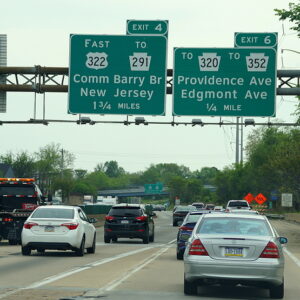For years, Philadelphia commuters have complained — or even bragged — about having the worst traffic in America.
And now it is official.
Data analysis by Wallethub.com ranked Philadelphia dead last on its list of ‘Worst Cities for Driving.’ The site’s study considered factors including traffic volume or congestion, infrastructure, and the cost of owning and maintaining a vehicle. The ‘Bottom 10’ included Los Angeles, Seattle, Baltimore, Washington, D.C., New York, Chicago, San Francisco, Oakland, Detroit, and Philadelphia, in that order.
What makes driving in and around Philadelphia so angst-inducing? The sheer volume of traffic is an issue, of course. But other factors are in play as well.
Vince Paraveccchia works in the Juniata Park section of Philadelphia. Before this year he worked in the Oxford Circle section of the city. Paravecchia cites factors that make his daily commute from Bucks County a challenge.
“Traffic is awful,” he said. “I-95 is an absolute nightmare every morning and afternoon. There’s always a project which is barely being worked on, and it slows everything up and causes countless jams.
“Double the problems if it is raining. I’ve gotten to the point where I’d rather drive in a blinding snowstorm in Philly than a foggy, chilly rainstorm. Why? Because many of the bad drivers stay home in the snow.”
Paravecchia notes road conditions, including or especially those on major thoroughfares, add to drivers’ woes.
“There is no road in America I’ve been on worse than the Schuylkill,” he said. “I’ve driven (I-5) near Los Angeles and been a passenger in L.A. I’ve done the entire length of the Garden State Parkway, the George Washington Bridge, and New York City. The Taconic Parkway. I-287 (in New Jersey). Connecticut. Atlanta (been through with my brother but I wasn’t the driver). Florida. D.C., Boston. Pittsburgh. San Diego. They are all better than Philly. The only places that rival Philly are Delaware near Wilmington and the Maryland border (with lots of volume with nowhere to go) and parts of New York City and Boston. But in my opinion, Philadelphia is the most maddening.”
The cost of vehicle maintenance is another source of aggravation for drivers. Jill Gonzalez is a public policy expert for WalletHub.com.
“One of the reasons Philadelphia is the worst city to drive in is the high cost of ownership and maintenance,” she said. “For example, the city has the third highest average monthly car insurance premium at almost $300.”
Gonzalez cites other factors that add to the stress of driving in the city.
“Philadelphia doesn’t fare well in terms of infrastructure,” she said, “considering the poor quality of bridges where it ranks in the bottom 10. Plus, the city has a significantly higher accident likelihood compared to the national average more specifically, 67 percent higher.”
That accident rate is fueled in part by the sheer volume of traffic on narrow city streets. The problem is magnified by phenomena including drivers who engage in unique driving practices, notably abrupt lane changes, perhaps from the far right to the left-turn lane, often without signaling or refusing to pull forward into an intersection from a left-turn lane.
Vic Monaco, who resides in Bucks County, spoke to the latter issue.
“The constant thing that drives me nuts is drivers who don’t pull halfway into an intersection when waiting to make a turn,” he said. “Not sure if this is taught (it is) but it’s just common sense and courtesy. When they do this, nine times out of 10 they are the only ones who get to make a turn because others don’t get to pull forward either.”
Other common issues are trucks from Amazon, UPS, and other delivery services blocking a lane while the driver makes a delivery, traffic signals that are out of synch resulting in long delays at intersections, and motorists getting caught in the middle of an intersection when the light changes.
Drivers accept situations like those described above as things that go along with urban driving. Gonzalez suggests carpooling as a way to deal with the volume of traffic.
“Carpooling or using public transportation whenever possible are great ways to avoid and reduce traffic congestion,” she said. “That would not only lead to reduced travel time but can also lower the costs of a commute. Biking or walking to work where applicable are other ways to avoid congestion.”
For many drivers, however, carpooling is not an opinion. So, for the time being, motorists are advised to be patient, allow for extra travel time, and hope their patience lasts longer than their commute.
Please follow DVJournal on social media: Twitter@DVJournal or Facebook.com/DelawareValleyJournal

